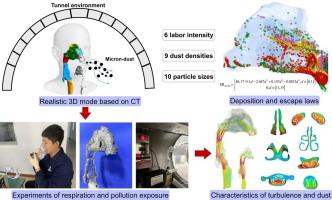Migration and deposition characteristics of micro-dust in the human upper airway in dust-polluted tunnel environments
IF 12.2
1区 环境科学与生态学
Q1 ENGINEERING, ENVIRONMENTAL
引用次数: 0
Abstract
Dust pollution in coal mine tunneling environment can cause serious hazards. This study presents a numerical analysis of the migration, deposition and escape characteristics of micro-dust in the human upper airway (HUA) under different labor intensities. The maximum deviation between simulation and experimental results was 8.97 %. The findings reveal that the expiratory flow was affected by the secondary motion, and two secondary vortices were formed around the posterior pharyngeal wall, which was prone to dust deposition. As the expiratory intensity increased, a large amount of 1–15 μm small-sized dust was deposited in the pharynx, and the deposition fraction (DFd) of 15 μm dust increased the most, reaching 77.13 %; 20–80 μm large-sized dust was difficult to exhale, and most were deposited near the nasal turbinate and nasopharynx. With the increase of density, the escape rate (ERd) of 1–15 μm dust showed a decreasing trend. The deposition of large-sized dust over 20 μm in nasopharyngeal region was more affected by density changes, but this fluctuation was reduced with increasing particle size. The study will help assess the human health risks of dust environment, develop more effective dust monitoring and control technologies and strategies for a cleaner, safer working air environment.

求助全文
约1分钟内获得全文
求助全文
来源期刊

Journal of Hazardous Materials
工程技术-工程:环境
CiteScore
25.40
自引率
5.90%
发文量
3059
审稿时长
58 days
期刊介绍:
The Journal of Hazardous Materials serves as a global platform for promoting cutting-edge research in the field of Environmental Science and Engineering. Our publication features a wide range of articles, including full-length research papers, review articles, and perspectives, with the aim of enhancing our understanding of the dangers and risks associated with various materials concerning public health and the environment. It is important to note that the term "environmental contaminants" refers specifically to substances that pose hazardous effects through contamination, while excluding those that do not have such impacts on the environment or human health. Moreover, we emphasize the distinction between wastes and hazardous materials in order to provide further clarity on the scope of the journal. We have a keen interest in exploring specific compounds and microbial agents that have adverse effects on the environment.
 求助内容:
求助内容: 应助结果提醒方式:
应助结果提醒方式:


